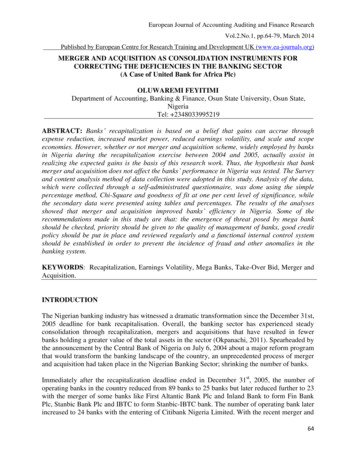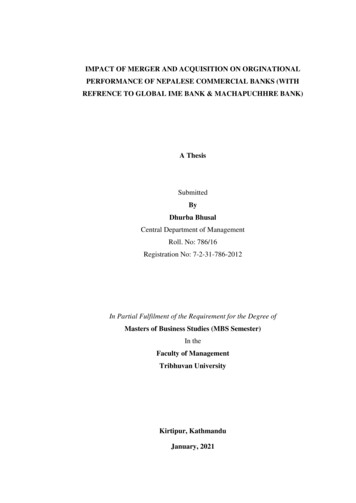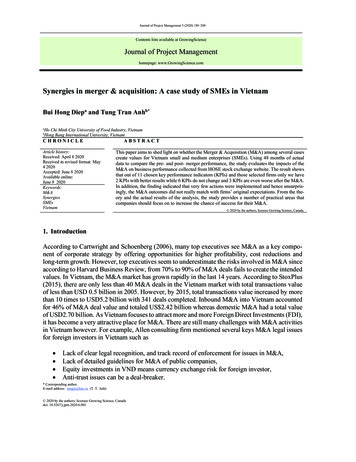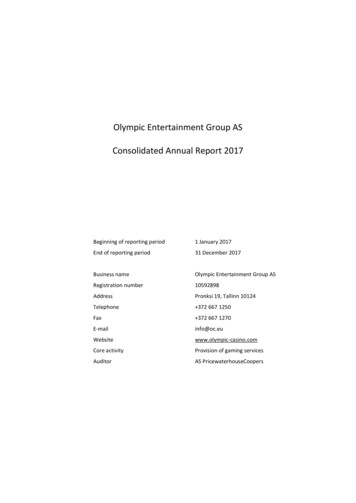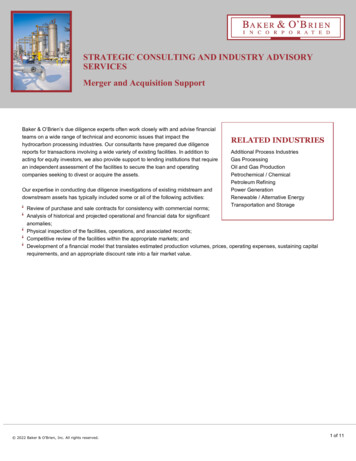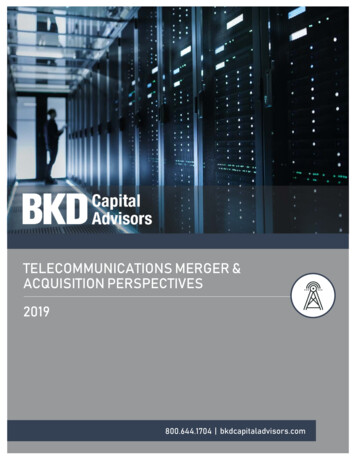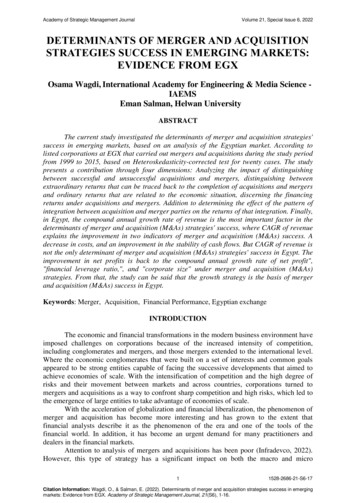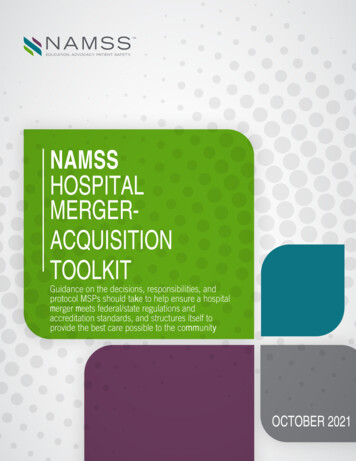
Transcription
NAMSSHOSPITALMERGERACQUISITIONTOOLKITGuidance on the decisions, responsibilities, andprotocol MSPs should take to help ensure a hospitalmerger meets federal/state regulations andaccreditation standards, and structures itself toprovide the best care possible to the communityOCTOBER 2021
Table of ContentsDisclaimer . 2Toolkit Purpose . 2Introduction to the Hospital Merger-Acquisition Toolkit . 3Culture and Communications Teams . 4Due Diligence of Hospital M&A . 5Governing Board . 6Federal and State Hospital Regulations . 6Hospital Accreditation, Disease, and Other Hospital Certifications . 7Newly M&A Hospital: Impact on MSPs and Medical Staff. 8Documents . 9Developing Health System-Wide Clinical Privileges . 9Peer Review .10Decision on Credentialing Software .10Contracts .11Keys to Successful Integration .11The Future of M&As .11Conclusion.121 HOSPITAL MERGER-ACQUISITION TOOLKIT
DisclaimerThis document is a compilation of information from organizations, including state governmentsand accreditation agencies to assist Medical Services Professionals (MSPs) when a hospitalannounces it is merging with another hospital.This information was collected by National Association Medical Staff Services (NAMSS) membersand NAMSS staff and compiled by NAMSS and its strategic partners to provide a rapid-accessHospital Merger-Acquisition Toolkit for MSPs and hospitals.This Toolkit is not intended as guidance from NAMSS. It does not replace or serve as asubstitute for regulations, accreditation standards, or policy. This Toolkit is solely aninformational product offered by NAMSS to MSPs and to hospitals.NAMSS will update this document on an on-going basis to ensure all new and innovativeapproaches are reflected to provide states with strategies to continue addressing hospitalclosures. MSPs may submit updates to info@namss.org, ATTN: Hospital Merger-AcquisitionToolkit.Toolkit PurposeThe NAMSS Hospital Merger-Acquisition Toolkit is a resource for Medical Services Professionals(MSPs) involved in developing and launching a merged or acquired hospital. The Toolkitprovides guidance on the decisions, responsibilities, and protocol MSPs should take to helpensure a hospital merger(s)/acquisition meets federal/state regulations and accreditationstandards, and structures itself to provide the best care possible to the community. MSPs play acritical role in a hospital’s merger/acquisition process. Their early involvement can help ensure ahospital’s merger/acquisition practitioner-credentialing process follows best practice and enablesMSPs to work at the top of their scope.2 HOSPITAL MERGER-ACQUISITION TOOLKIT
Introduction to the HospitalMerger-Acquisition ToolkitU.S. hospital-mergers and acquisitions (M&A) continue to trend upward (Figure 1),1 as standalone hospital expenses challenge sustainability and hospital systems seek to expand theirnetworks and geographical reach. According to a 2015 American Hospital Association’s survey,nearly 60 percent of the approximately 5,000 U.S. hospitals are part of a health system. Bothbuyers and sellers can benefit from M&A, which can result in operational improvements,strategic growth, consolidated competitors, and increased financial value to that system.A 2017 Deloitte assessment of hospital M&A, stated that between 2008 and 2014, over 750hospital acquisitions or mergers took place in the United States. The Deloitte report credits thistrend to pursuing economies of scale, decreasing unit costs by consolidating operations, andimproving productivity and outcomes through increased volumes. M&A enables larger,consolidated health-systems, resulting from an acquisition or merger, to focus more oninvestments in technology, quality improvement, ancillary services, as well as shared servicesacross a broader base, post-transaction. 21Irving Levin Associates, Health Care M&A News.2Deloitte. Hospital M&A: When done well, M&A can achieve valuable outcomes. us-lshc-hospital-mareport-v2.pdf3 HOSPITAL MERGER-ACQUISITION TOOLKIT
As hospital M&A rates continue to trend upward, MSPs play an important role in providinginsight and guidance on merging and establishing medical staff departments by doing thefollowing: Understanding the hospital system’s vision for pursuing the transaction.Setting and communicating goals for merging departments.Remaining accountable to leaders.Identifying, understanding, and navigating cultural differences between the hospitals.Communicating decisions to colleagues and hospital leaders.Following medical staff best practices for integrating the acquired or mergedorganization an established system.Communicating decisions to colleagues and hospital leaders. Implement projectmanagement best practices that include goals with timeline-based project plans. 3The elements above will enable MSPs within the parent hospital system to help hospitalleadership identify and eliminate duplications resulting from a merger or acquisition. MSPsshould work with the hospital administrator overseeing the transaction to set goals and projecttimelines for medical staff-related projects and communicate these goals and timelines tohospital leadership.Many MSPs have experienced hospital M&As and can attest to the unforeseen and anticipatedchallenges, mistakes, and successes of these transactions. MSPs’ communications andinteractions with those overseeing a hospital M&A on the goals and needs of merging medicalstaffs is critical to the success of the transaction.Culture andCommunications TeamsTo help an M&A transaction meet goals to improve quality of care, MSPs should work withhospital leadership to identify a “Quality Leader” to help keep these goals at the forefront ofany directional decisions. Without directional leadership, silos can form and medical staffs fromboth hospitals may not collaborate or combine efforts to establish and implement best practicesand intellectual property.4Hospital medical staff culture is unique to each hospital and sudden changes, such as an M&Acan be disruptive. It is important for MSP leaders to recognize that each hospital is unique.Respectful communication between both hospitals’ medical staffs is critical to a successful M&A.Developing a plan to navigate identified culture differences can help merged systems meet their3Ibid.Deloitte. Hospital M & A: When done well, M&A can achieve valuable outcomes. us-lshc-hospitalma-report-v2.pdf.44 HOSPITAL MERGER-ACQUISITION TOOLKIT
strategic goals and achieve successful metrics that benefit everyone.5 The timeframe to addresshospital cultures should be realistic and focus on patient safety and quality care.Communications and coordination among and within the teams developing a M&A hospital’sinfrastructure is key to meeting benchmarks to merge hospitals. MSPs interact with, and are apart of, several of these teams and need to understand how each team works and affects thehospital’s medical staff. Building relationships within the following teams is critical to ensuringMSPs have a voice in merging the hospitals’ medical staff services department structure: Legal (Medical-Staff Bylaws, Hospital Policies and Procedures, Medical-MalpracticeInsurance Requirements, Peer-Review Requirements, etc.)Administration (Budget, Medical Staff Reporting Structure, Medical-Staff OfficerAppointments)Quality and Patient Safety (Leap Frog indicators, HCAHPS, Stroke, etc.)Information Technology Services (Electronic Medical Record, Credentialing Software, ITequipment, Medical Staff IT Support)Human Resources (Practitioner Employment, Contracted Medical Personnel)Health Plans Contracts (Delegated Credentialing)Revenue-Cycle TeamRegulatory and Accreditation (CMS, State Law, the Joint Commission/ACHC/DNV)Medical Staff Leadership (Cultural integration and alignment is fundamental to anysuccessful attempt to bring physicians into an organization in a coordinated andfunctional way).6Onboarding and RecruitmentProvider Enrollment (Change of Address, Payer, Contracts, Notification of EffectiveDate).Due Diligence of Hospital M&AEvaluating potential or actual compliance risks is necessary during a hospital transaction. M&Ascan be especially complicated because of the highly regulated hospital industry. Acquiringhospitals can inherit serious regulatory liabilities. Similarly, hospitals seeking to join a largersystem may not fully know the risks they take during a transaction.The acquiring hospital MSP may need to pre-audit credentialing files; credentialing databaseevaluation; medical staff-department structure, policies, and processes; review medical staffbylaws, rules, and regulations; and malpractice claims currently in place, which involve currentpractitioners with clinical privileges.56Ibid.Burroughs, John. “Resign the Medical Staff Model.” 2015.5 HOSPITAL MERGER-ACQUISITION TOOLKIT
Governing BoardHospital M&As must determine if the M&A hospital’s board members will maintain theirmembership, will a new board selected, or incorporate the board into the health system board.The Hospital M&A contract terms make this determination, and the newly M&A hospital boardwill approve all the following documents and decisions: Medical Staff Bylaws (Governance, medical staff categories, qualifications, history andphysical, etc.)Selection of Medical Executive Committee MembersCredentials Policy (Medical Staff)Organizational Manual (Medical Executive Committee, Credentials Committee, PatientSafety & Quality Committee, etc.)Advance Practice Clinician PolicyRules and RegulationsSpecialty Clinical Privileges (Determine if privileges will be revised to be included intoHospital M&A as applicable).Set Meeting Dates and TimesProvide Document of Necessary Items to Be ApprovedDetermine Hospital & Disease Specific Accreditation StatusFederal and StateHospital RegulationsThe Centers for Medicare and Medicaid Services (CMS) and the State Department of Healthshould be notified of the M&A contract as soon as possible. Other legal documents may need tobe filed with the appropriate county and may be required to approve the M&A. It is critical thatMSPs understand and speak to CMS regulations and interoperative guidelines, as well as statehospital regulations, when a hospital develops its compliance infrastructure as a new M&Ahospital. All MSPs of an M&A need to understand the scopes of practice for the medical board,nursing board and other advanced-practice clinicians as may differ among states. Centers for Medicare & MedicaidState Hospital RegulationsState Medical BoardState Nursing Board6 HOSPITAL MERGER-ACQUISITION TOOLKIT
Hospital Accreditation, Disease,and Other Hospital CertificationsM&A hospitals may have the same hospital accreditation or maybe different. The hospitals maydecide to keep both accreditations until one of them expires and transfers to the otheraccrediting organization. It will be important to review the following hospital-accreditationmanual chapters below. Review Accreditation Requirements for Newly Merged Hospitalo Does the same organization accredit both hospitals?o Newly merged hospitals will need to undergo a new survey due to neworganizational structure.Medical Staff ChapterLeadership ChapterEmergency ChapterThe Joint Commission, for example, has several Hospital Certifications by Setting:7 Evolving with CareCardiac CertificationOrthopedic CertificationStroke CertificationDisease-Specific CareIntegrated CareMaternal Level Of Care VerificationMedication CompoundingPerinatal CarePalliative CarePatient Blood ManagementPrimary Care Medical HomeMedical Staff ServicesM&A hospital medical staff services departments can be one of the most challenging andsuccessful opportunities for MSPs. Those in these scenarios may have different perspectives onthe M&A depending on if the side of the M&A the MSP is affiliated. MSPs on both sides will needto understand change and the underlying positives and negatives. Communication, asmentioned above, will be key to promote the vision, the future of the department and anychanges. M&As will become more efficient with some of the possible changes below. 7Paper to ElectronicMedical Staff Bylaws, Medical Staff Policies, Rules and Regulations StandardizationHealth System Uniform Clinical PrivilegesThe Joint Commission Website, September 26, 2021. https://www.jointcommission.org/7 HOSPITAL MERGER-ACQUISITION TOOLKIT
Focused Professional Practice Evaluation, Ongoing Professional Practice Evaluation, PeerReview, and Quality Indicators ReviewCredentials Verification Organization (CVO)One Medical Staff (all participating hospitals would need to follow requirements to makethis change)Formal Education and Training for MSPsStaffing evaluation and working with Human Resources on medical staff job descriptionsand qualificationsReduction of Retraining of MSPs to other job descriptions within Medical Staff Servicesand CVO.Newly M&A Hospital: Impact onMSPs and Medical StaffChallenges, successes, and failures are all part of an M&A. It is important for MSPs tocommunicate with their leadership throughout the M&A. An MSP experiencing an M&A mayneed to update his/her resume and begin to look for other opportunities as an MSP. This is agood exercise to do every six months. The MSP may want to review his/her existing jobdescription and determine if it is current.MSPs should also start notating all job responsibilities, duties, and any extra education/trainingacquired. Because the MSP role continues to evolve, MSPs should continuously update resumesand work experience to reflect changing roles. An updated resume will be a goodcommunication tool and resource for any interviews MSPs may need to have with the newlyformed hospital system.MSPs will help the newly formed M&A hospital’s medical staff for communicate, support, andpromote the new medical staff’s vision. Some of medical staff changes that may occur include: 8Redesigned process flows to make practitioners more efficient, reliable, and costeffectiveCreating service initiatives to drive patient and stakeholder loyalty and drive marginOperationalizing service lines and clinical institutesOperationalizing important IT initiatives to improve care, minimize disruption, andreduce costsHealth system clinical privilege redesign with consistent criteriaChanges to operating, business and marketing plansCompensation planQuality plan with approval of specific metrics or targetsPerformance dashboard or scorecard consistent with the organization’s strategic planRecruitment and oversight performance measure of relevant medical directors. 8Burroughs, John. “Resign the Medical Staff Model.” 2015.8 HOSPITAL MERGER-ACQUISITION TOOLKIT
DocumentsThe newly M&A hospital’s governing board shall draft and approve all hospital documents.These documents will guide MSPs on the medical staff services department’s governance andorganization, qualifications, and responsibilities, credentialing policies, fair-hearing procedures,and rules and regulations. These documents may include: Medical Staff BylawsCredentials Policy – Medical StaffCredentials Policy – Advance Practice ProfessionalsFair Hearing Policies and ProceduresOrganizational ManualRules & RegulationsApplication for Medical Staff and Advance Practice Professionals.Additional Medical-Staff Documents may include: Focused Professional Practice Evaluation (FPPE)Ongoing Professional Practice Evaluation (OPPE)Peer Review PoliciesProfessionalism PolicyEmergency Call PolicyConflict of Interest PolicySenior Physician Requirements/Aging Physician PolicyResponse to References PolicySharing of Peer Review Policy (Large Hospital System)Developing Health SystemWide Clinical PrivilegesReal-life cases demonstrate the need for consistent and comprehensive quality credentialing,privileging, and peer-review processes, especially across hospital systems. A centralized andstandardized system for practitioner verification can help ensure consistency for all credentialingdecisions. A system-wide credentialing committee can help ensure that all only vettedapplications undergo final board review. Inconsistencies in assessing practitioners within9 HOSPITAL MERGER-ACQUISITION TOOLKIT
hospital systems can cause time- and resource-consuming delays, as well as potential legalissues. 9Healthcare restructuring resulting from an M&A, require consistency across newly formed ormerged systems to ensure that all practitioners within the system are competent and qualified.These structural shifts need to align clinical service lines and collect and the growing emphasison value-based care models require systems to focus more on measurement and reporting.MSP assessments of practitioner behavior and patient experience will continue to be importantin determining clinical privileges.A system’s standardization and consistency in awarding clinical privileges can reduce turnaroundtime and duplicative efforts during the initial appointment process. Practitioners prefer tocomplete one application for numerous hospitals in the same system than one for each hospital,which improves practitioner satisfaction with the credentialing process.Peer ReviewM&As can help improve systematic processes for sharing peer review, which can prevent apractitioner from moving within the hospital system under the radar, and making the samemistakes. Hospital systems should develop a structured process for sharing and protectinginformation, in accordance with state peer review privileges laws. Medical staff bylaws shouldinclude provisions that enable all hospitals within a system to adhere to a one hospital’scorrective action or medical staff appointment/privileging decision.10Decision on Credentialing SoftwareDuring an M&A, the hospitals need to select a credentialing software for official use. If acredentials verification organization (CVO) already exist within the system, the M&A hospital willhave their credentialing data transferred to the system credentialing software. MSPs will need tohelp develop a timeline to execute this integration and the CVO’s start date for the resultingM&A hospital. Setting up security, training MSPs, and implementing the system all need to takeplace, ideally under the guidance of a manager. Medical Staff services departments and CVOsusually include personnel with IT expertise.9Schumacher, Avery and Kleinman, Stephen R. “Sharing Credentialing, Privileging, and Peer ReviewInformation with Systems.” Bricker & Eckler LLP, Columbus, OH. April 29, ions/Ohio/Sharing%20of%20PRI%20Article AHLA%20MSCPR%20(CLEAN)%20(1)%20(2).pdf?ver 2020-12-23-124512-46310Ibid.10 H O S P I T A L M E R G E R - A C Q U I S I T I O N T O O L K I T
ContractsThe M&A hospitals will need to determine which hospital services to keep, cancel, orconsolidate. Contracted service in medical staff may include, but not be limited to, thefollowing: Hospital-Based Services (Anesthesiology, Emergency Medicine, Radiology, RadiationOncology, Pathology, Hospitalists Services (Neonatal, Pediatrics, Internal Medicine, etc.)Telehealth ServicesVerification Services and credentialing software contractsKeys to Successful IntegrationMSPs will want all the hospitals to be successful. This takes time, dedication, empathic listening,and the willingness to change. Some of the keys to success include: Physician Leadership SupportProject ManagementCommunication, Communication, CommunicationEducationLessons LearnerReevaluation and Performance ImprovementLegal Support (Internal and External)RespectEmbrace ChangeHuman Resources InvolvementOrganizational StructureImproved Quality & Patient SafetyThe Future of M&AsWhile COVID-19 caused a significant reduction in M&A, it is likely that M&A activity willeventually exceed the pre-COVID trends.11 MSPs can equip themselves now for future M&A toensure that they take advantage of leadership opportunities and provide a needed voice isestablishing, modifying, and arranging a medical staff service department resulting from anM&A.11Diamond, Brandee L., Lehot, Louis, Chow, Eric. “Healthcare Shines in M&A’s Major Comeback So Far In2021.” April 12, 2021.11 H O S P I T A L M E R G E R - A C Q U I S I T I O N T O O L K I T
ConclusionHospital M&A can be disruptive, but also provide opportunities for MSPs to take leadership rolesand ensure the integrity of the newly realigned medical staff department. Each step taken tomerge or acquire a hospital effects the end-result. Equally critical to this success is ensuringthat those with medical staff knowledge, experience, and perspective take part in the hospital’sdevelopment. MSP input is critical each step of the way and MSPs should feel empowered totake a leadership role and work closely with hospital administrators throughout the transaction.MSP expertise and insight will help develop, promote, and enhance successful hospitalcredentialing programs. The NAMSS Hospital Merger-Acquisition Toolkit provides MSPs guidanceon the protocol they should follow, the processes they should ensure, and vision they shouldseek when helping to achieving an optimal medical staff department. NAMSS continues to serveas a resource for MSPs partaking in this critical work. Please send any questions about theHospital Merger-Acquisition Toolkit to info@namss.org.12 H O S P I T A L M E R G E R - A C Q U I S I T I O N T O O L K I T
ensure a hospital merger(s)/acquisition meets federal/state regulations and accreditation standards, and structures itself to provide the best care possible to the community. MSPs play a critical role in a hospital's merger/acquisition process. Their early involvement can help ensure a
